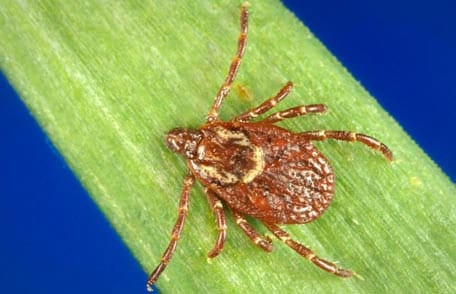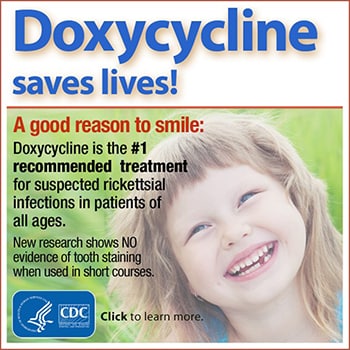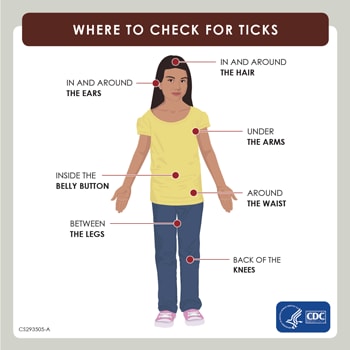RMSF: deadly, but preventable

Do you know about Rocky Mountain spotted fever (RMSF), the most deadly tickborne disease in the world?
Rocky Mountain spotted fever (RMSF) is a serious, sometimes deadly, bacterial disease spread through the bite of an infected tick.
- Roughly 4,000-6,000 tickborne spotted fevers, including RMSF, are reported in the United States each year.
- More than 60% of reported RMSF cases occur in five states (North Carolina, Tennessee, Oklahoma, Arkansas, and Missouri).
- While the majority of RMSF cases occur during summer months, ticks can still bite you during the spring, fall, or even year-round in warmer climates.
Signs and Symptoms
Early signs of RMSF are often non-specific with symptoms such as fever and headache. RMSF can progress to a serious and life-threatening illness in days. Early signs and symptoms may include:
- Fever
- Headache
- Rash, usually occurs around days 2-5
- Nausea, vomiting
- Stomach pain
- Muscle pain
- Lack of appetite

Treatment
- Doxycycline is the treatment of choice for adults and children of all ages with suspected RMSF as recommended by the CDC and the American Academy of Pediatricsexternal icon.
- If treated in the first 5 days with doxycycline, people with RMSF typically recover. While those treated after day 5 of illness may experience a more severe illness requiring hospitalization, or intensive care.
- When left untreated, the bacteria can cause damage to blood vessels throughout the body leading to organ and tissue damage.
- RMSF can be fatal, even in previously healthy people. If not treated correctly, death can often occur within eight days of symptoms starting.
- People who do recover from serious RMSF infections may be left with life-altering damage, including amputation of arms, legs, fingers, or toes (from lack of blood flow), hearing loss, paralysis, or mental disability.
Diagnosis and Testing
- Diagnosis is made by a healthcare provider based on a person’s signs, symptoms, and possible exposure to ticks.
- Your healthcare provider may order certain blood tests to look for evidence of RMSF. Results may take weeks.
- Treatment with doxycycline should never be delayed while waiting for diagnostic test results.
Prevent RMSF. Protect yourself, your family, and your pets from tick bites.
- No vaccine to prevent RMSF is available. Prevent infection by preventing tick bites.
- Ticks live in grassy, brushy, or wooded areas, or even on animals.
- Spending time outside camping, gardening, or hunting can bring you in close contact with ticks.
Before You Go Outdoors
Know where ticks live. Ticks prefer moist and humid environments, particularly in or near wooded or grassy areas. You may come into contact with ticks during outdoor activities, around your home, or when walking through leaf litter or near shrubs. Always walk in the center of trails in order to reduce the chance of contacting ticks.
Use Environmental Protection Agency (EPA) registered insect repellent on skin.
- Use insect repellents containing DEET, picaridin, IR3535, oil of lemon eucalyptus (OLE), para-menthane-diol (PMD), or 2-undecanone to repel ticks for several hours.
- The EPA has an online tool to help you select the repellentexternal icon that is best for you and your family.
- Always follow product instructions.
- Parents should apply these products to their children, avoiding the hands, eyes, and mouth.
- Do not use insect repellent on babies younger than 2 months old.
- Do not use products containing OLE or PMD on children under 3 years old.
Treat clothing and gear with permethrin. Permethrin kills ticks and can be used to treat boots, clothing, and camping gear. Clothing treated with 0.5% permethrin will provide lasting protection even after several washings.
Treat your pets for ticks. Dogs are highly susceptible to tick bites and tickborne diseases.
- A variety of tick prevention products are available including tick collars, sprays, and oral medications.
- Use tick prevention products for animals regularly to protect your dogs and family from tick bites.
- Cats are extremely sensitive to many chemicals. Do not apply any insecticides, tick products, or insect repellents to your cat without first talking to your veterinarian!
- Talk to your veterinarian about the best choice of tick prevention product for your pet. For more information on animals and health, see Preventing Ticks on Your Pet.
- For detailed information about tick prevention and control, see: Avoiding Ticks.

Check your body for ticks after coming indoors.
After You Come Indoors
Check your clothing and gear for ticks. Ticks can ride into the home on clothing and pets. Remove ticks if you find them.
- Tumble dry clothes in a dryer on high heat for 10 minutes to kill ticks on dry clothing after you come indoors.
- If the clothes are damp, additional time may be needed. If the clothes require washing first, hot water is recommended. Cold and medium temperature water will not kill ticks effectively.
Check your dogs for ticks after returning from tick habitats. The most common location for ticks on dogs include the ears, armpits, groin, around the paws, and in-between the toes.
Bathe or shower as soon as possible after coming indoors (preferably within two hours) to wash off and more easily find ticks that are crawling on you.
Check your body for ticks after being outdoors. Check your body for ticks! If you have kids, check them for ticks. Use a mirror or have someone help you with hard-to-see areas. Ticks can be found anywhere, but are commonly found:
What to Do if You Find an Attached Tick
- Remove any attached ticks from people or pets immediately.
- To remove a tick, grasp it with tweezers as close to the skin as possible, and pull it straight out. Do not twist or jerk. For detailed information about tick removal, see the Tick Removal page.
- Watch for signs of illness in people and pets after spending time in tick habitats, even if you don’t remember a tick bite. Remember, RMSF and other tickborne diseases can be treated effectively with doxycycline if caught early.
- See your healthcare provider immediately if you develop a fever, rash, or flu-like symptoms. Be sure to tell your healthcare provider if you were recently bitten by a tick or enjoy outdoor activities where you might have been in contact with ticks.
If you get RMSF, you will always develop a rash.
FALSE. While most people do develop a rash at some point during their illness, this may not occur until a person has been sick for many days. If you develop a fever or rash after spending time in tick habitats, see a healthcare provider immediately.
I don’t remember being bitten by a tick, so my illness can’t be caused by an infected tick.
FALSE. Tick bites are painless and often go unnoticed. In fact, only 6 in 10 people who got RMSF remember a tick bite.
Doxycycline can’t be given to children because it may stain their teeth.
FALSE. Doxycycline is the treatment of choice for people of all ages who are suspected of having RMSF. Recent studies have shown that doxycycline does not cause tooth staining when used in short courses (like those used to treat RMSF).
For more information on RMSF, visit our website.
New tools and resources are available for healthcare providers, visit the healthcare provider resources page.